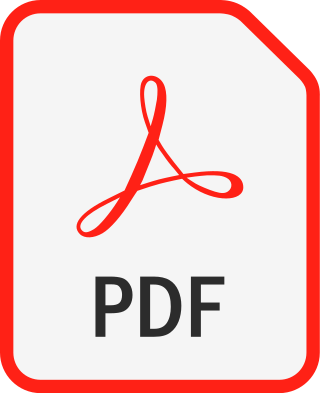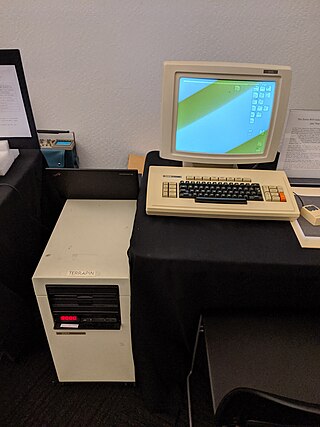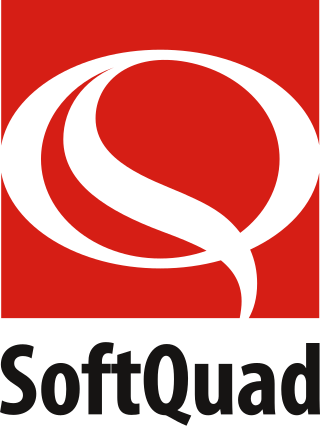
Lisp machines are general-purpose computers designed to efficiently run Lisp as their main software and programming language, usually via hardware support. They are an example of a high-level language computer architecture, and in a sense, they were the first commercial single-user workstations. Despite being modest in number Lisp machines commercially pioneered many now-commonplace technologies, including effective garbage collection, laser printing, windowing systems, computer mice, high-resolution bit-mapped raster graphics, computer graphic rendering, and networking innovations such as Chaosnet. Several firms built and sold Lisp machines in the 1980s: Symbolics, Lisp Machines Incorporated, Texas Instruments, and Xerox. The operating systems were written in Lisp Machine Lisp, Interlisp (Xerox), and later partly in Common Lisp.

Portable Document Format (PDF), standardized as ISO 32000, is a file format developed by Adobe in 1992 to present documents, including text formatting and images, in a manner independent of application software, hardware, and operating systems. Based on the PostScript language, each PDF file encapsulates a complete description of a fixed-layout flat document, including the text, fonts, vector graphics, raster images and other information needed to display it. PDF has its roots in "The Camelot Project" initiated by Adobe co-founder John Warnock in 1991. PDF was standardized as ISO 32000 in 2008. The last edition as ISO 32000-2:2020 was published in December 2020.

PostScript is a page description language and dynamically typed, stack-based programming language. It is most commonly used in the electronic publishing and desktop publishing realm, but as a Turing complete programming language, it can be used for many other purposes as well. PostScript was created at Adobe Systems by John Warnock, Charles Geschke, Doug Brotz, Ed Taft and Bill Paxton from 1982 to 1984. The most recent version, PostScript 3, was released in 1997.
Quicksilver may refer to:
Symbolics, Inc., was a privately held American computer manufacturer that acquired the assets of the former company and continues to sell and maintain the Open Genera Lisp system and the Macsyma computer algebra system.

Computer-aided design (CAD) is the use of computers to aid in the creation, modification, analysis, or optimization of a design. This software is used to increase the productivity of the designer, improve the quality of design, improve communications through documentation, and to create a database for manufacturing. Designs made through CAD software help protect products and inventions when used in patent applications. CAD output is often in the form of electronic files for print, machining, or other manufacturing operations. The terms computer-aided drafting (CAD) and computer-aided design and drafting (CADD) are also used.
Desktop publishing (DTP) is the creation of documents using dedicated software on a personal ("desktop") computer. It was first used almost exclusively for print publications, but now it also assists in the creation of various forms of online content. Desktop publishing software can generate page layouts and produce text and image content comparable to the simpler forms of traditional typography and printing. This technology allows individuals, businesses, and other organizations to self-publish a wide variety of content, from menus to magazines to books, without the expense of commercial printing.

Genera is a commercial operating system and integrated development environment for Lisp machines created by Symbolics. It is essentially a fork of an earlier operating system originating on the Massachusetts Institute of Technology (MIT) AI Lab's Lisp machines which Symbolics had used in common with Lisp Machines, Inc. (LMI), and Texas Instruments (TI). Genera was also sold by Symbolics as Open Genera, which runs Genera on computers based on a Digital Equipment Corporation (DEC) Alpha processor using Tru64 UNIX. In 2021 a new version was released as Portable Genera which runs on Tru64 UNIX on Alpha, Linux on x86-64 and Arm64 Linux, and macOS on x86-64 and Arm64. It is released and licensed as proprietary software.

A workstation is a special computer designed for technical or scientific applications. Intended primarily to be used by a single user, they are commonly connected to a local area network and run multi-user operating systems. The term workstation has been used loosely to refer to everything from a mainframe computer terminal to a PC connected to a network, but the most common form refers to the class of hardware offered by several current and defunct companies such as Sun Microsystems, Silicon Graphics, Apollo Computer, DEC, HP, NeXT, and IBM which powered the 3D computer graphics revolution of the late 1990s.

Adobe FrameMaker is a document processor designed for writing and editing large or complex documents, including structured documents. It was originally developed by Frame Technology Corporation, which was bought by Adobe.

The Xerox Star workstation, officially named Xerox 8010 Information System, is the first commercial personal computer to incorporate technologies that have since become standard in personal computers, including a bitmapped display, a window-based graphical user interface, icons, folders, mouse (two-button), Ethernet networking, file servers, print servers, and email.
A de facto standard is a custom or convention that has achieved a dominant position by public acceptance or market forces. De facto is a Latin phrase, here meaning "in practice but not necessarily ordained by law" or "in practice or actuality, but not officially established".
A music workstation is an electronic musical instrument providing the facilities of:

BroadVision, Inc. is an international software vendor of self-service web applications for enterprise social software, electronic commerce, enterprise portals, and customer relationship management. The company provides applications to businesses. In addition, the company provides toolkit, framework, library for extending its products and services. The company is headquartered in Redwood City, California, United States. It was founded on May 13, 1993, by Pehong Chen, and its initial public offering took place in 1996.

Harlequin was a technology company based in Cambridge, UK and Cambridge, Massachusetts. It specialized in application software for printing, graphics, law enforcement, artificial intelligence, and in implementations of programming languages. Harlequin employees sometimes referred to themselves as "The 'Late Binding' company" and the firm eventually evolved into a think tank for advanced technologies.
Information International, Inc., commonly referred to as Triple-I or III, was an early computer technology company.

SoftQuad Software was a Canadian software company best known for HoTMetaL, the first commercial HTML editor. It is also known for Author/Editor, the first specialized SGML editor, and Panorama, the first browser plugin for SGML. Panorama demonstrated the need for standardization of SGML on the web, which eventually resulted in the development of the XML specification.
The Kodak Ektaprint Electronic Publishing System (KEEPS) was a professional electronic publishing system sold internationally by the Eastman Kodak Company from 1987–1992. KEEPS was a fully integrated turnkey system, consisting of publishing software from Interleaf, computer hardware from Sun Microsystems, customized front-end software developed by Kodak that ran on Unix System V Release 4, and Kodak's high-end scanners and Ektaprint printers and copiers.
Datalogics is a computer software company formed in 1967 and based in Chicago, IL. The company licenses software development kits for working with PDF and other document file types. They have previously developed their own typesetting and database publishing software. Since 1996, Datalogics has also acted as a channel for several SDKs from Adobe Systems. These include the Adobe PDF Library, Adobe Experience Reader Extensions, Adobe Content Server, Adobe InDesign Server, Adobe PDF Converter, Adobe PDF Print Engine and Adobe Reader Mobile SDK. In 2022, Datalogics launched a new business unit called pdfRest, an API toolkit for PDF processing.









